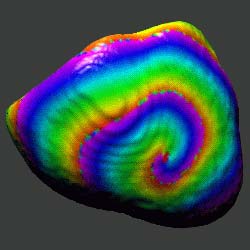Physics for ER

In the typical TV medical drama, a doctor grabs a pair of large electrodes, shouts, “Clear!” then jolts an unconscious patient’s chest with thousands of volts to revive him. In the real world, this and other treatments for heart attacks are crude and far from reliable, but to improve heart-starting technologies, researchers need to better understand what makes a heart go wrong. In the 30 July PRL researchers show, using computer simulations of the electrical waves in a heart, that much gentler electric shocks might be able to restore normal beating when an abnormal electrical wave is causing the problem.
Heart cells contract in response to an electrical signal. When the voltage across the cell membrane hits the right value, the cell reacts. To coordinate the blood-pumping motion of the cells, a wave of voltage sweeps across the heart periodically, activating cells as it travels. In the common disorder known as fibrillation, however, the heart’s electrical waves become disorganized, muscle cells contract and relax chaotically, and pumping ceases. Conventional defibrillator machines apply a large external voltage that stuns the heart into quiescence, in the hope that it will then resume normal beating. If not, death can follow in a few minutes.
If some heart cells have already died from a previous heart attack, fibrillation can create a spiral-shaped electrical wave that rotates around the dead region and becomes trapped in place. The spiral wave inhibits normal waves, just as eddies in a stream inhibit the smooth flow of water. A defibrillator implanted in the body can dispel one of these so-called pinned waves by applying a small voltage directly to the heart, but the electrode must be close to the dead zone. A team led by Valentin Krinsky and Alain Pumir of the Nonlinear Institute of Nice, France, and Igor Efimov of Case Western Reserve University in Cleveland, Ohio, now proposes that a small electric pulse applied to the heart as a whole may be able to deal with pinned rotating waves, regardless of their location.
Using a computer model that has held up well alongside animal experiments, the researchers analyzed pinned waves in a section of cardiac muscle. If the team applied just a few volts across the heart muscle for a few tens of milliseconds, a second, smaller spiral appeared. If they applied the pulse when the original spiral was in the right position in its rotation, the smaller spiral rotated in the opposite direction and partially cancelled the pinned wave near the dead zone, releasing it to spin away.
Since a modern implantable defibrillator is like a little computer, says Krinsky, it’s “not a problem” to imagine a device that could monitor heart activity and apply a pulse, with the right timing, if it detects a pinned wave. However, Bradley Roth of Oakland University in Rochester, Michigan, cautions that while unpinning a trapped wave may be a useful step, “you want to get rid of it” entirely to restore normal heart function. He notes that defibrillation techniques have developed in almost entirely an empirical way, and “we all hope these models will eventually lead to improvements.”
–David Lindley
David Lindley is a freelance science writer in Alexandria, Virginia.
More Information
University of Utah “Mathematical Cardiology” including pretty pictures


